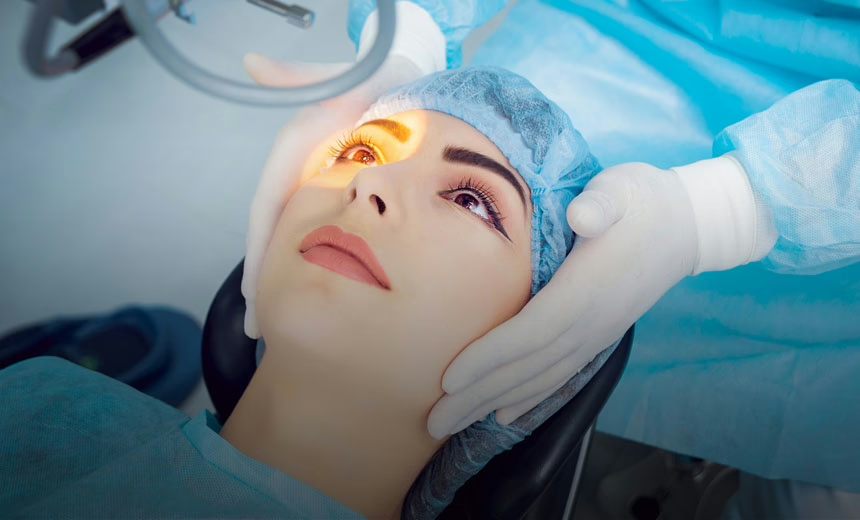"*" indicates required fields
Treating keratoconus with collagen cross-linking
26/08/2017

Keratoconus
Keratoconus is a condition that causes the round cornea of the eye to change shape over time. The tiny fibres of protein in the eye (called collagen) that normally support the cornea become weak with the onset of keratoconus. This eventually causes the cornea to lose its natural dome-like shape and become cone-shaped.
It can cause a number of changes to eyesight, including blurring of vision, bright lights appearing to be streaked, and glare and halos appearing at night.
Keratoconus is a progressive condition that has been reported in up to 1 in 84 Australians.1 It is an inherited and degenerative disorder and is usually diagnosed in the teenage or early adult years.
Rigid contact lenses and intracorneal ring segments help to correct the prescriptive error, but they don’t prevent further progression of keratoconus.
Prior to the availability of corneal collagen cross-linking to treat keratoconus, about 10–20% of patients eventually required a corneal transplant.2
What is collagen cross-linking and how does it work?
Collagen cross-linking is a medical procedure that employs the use of ultra-violet (UV) light and drops to help slow the progress of the condition.
Under topical anaesthesia, the superficial layer of the cornea is loosened before riboflavin drops (vitamin B2) are applied. The cornea is then exposed to UV light, which causes the riboflavin to fluoresce. In turn, this strengthens the bonds between the collagen molecules, stiffens the collagen fibres and, ultimately, strengthens the cornea.
The progress report
Collagen cross-linking isn’t a cure for keratoconus. However, in many cases, it is able to halt further progression of the condition. Most importantly, it can help slow visual deterioration and prevent the need for a corneal transplant.
This treatment changes the intrinsic biomechanical properties of the cornea and has been shown to strengthen the cornea by around 300%.3 Research to date indicates that it is very effective in slowing disease progression and may improve vision.
The results over periods of 3 and 5 years of a Dresden clinical study have indicated that in the case of 60 eyes researched, the progression of keratoconus had been stopped in all cases.4 In 31 of the eyes, there was a reversal and flattening of the cornea and visual acuity was improved. Similar success was found in a later study in which 241 eyes were observed for up to 6 years following the procedure.5 Only 2 of the patients showed signs of any further progression of the disorder, and they both responded successfully to re-treatment.
Many patients with keratoconus who may have faced undergoing a corneal transplant in the past, now have more options with the advent of corneal cross-linking. Equally, they may be able to retain a much higher standard of visual quality for a much longer period of time.
The future for collagen cross-linking
Collagen cross-linking may not be effective in halting progression in cases where the cornea is too thin (less than 350 microns). In such cases, alternative treatments might be considered, including lamellar keratoplasty and corneal ring implants (Intacs and Kerarings).
References/further reading
- Chan E, Chong EW, Lingham G, Stevenson LJ, Sanfilippo PG, Hewitt AW, Mackey DA, Yazar S. Prevalence of Keratoconus Based on Scheimpflug Imaging: The Raine Study. Ophthalmology. 2020 Aug 26;S0161-6420(20)30838-1. doi: 10.1016/j.ophtha.2020.08.020.
- Godefrooij DA, Gans R, Imhof SM, Wisse RP. Nationwide reduction in the number of corneal transplantations for keratoconus following the implementation of cross-linking. Acta Ophthalmol. 2016 Nov;94(7):675-678. doi: 10.1111/aos.13095.
- Alhayek A, Lu PR. Corneal collagen crosslinking in keratoconus and other eye disease. Int J Ophthalmol. 2015 Apr 18;8(2):407-18. doi: 10.3980/j.issn.2222-3959.2015.02.35.
- Wollensak G. Crosslinking treatment of progressive keratoconus: new hope. Curr Opin Ophthalmol. 2006 Aug;17(4):356-60. doi: 10.1097/01.icu.0000233954.86723.25.
- Raiskup-Wolf F, Hoyer A, Spoerl E, Pillunat LE. Collagen crosslinking with riboflavin and ultraviolet-A light in keratoconus: long-term results. J Cataract Refract Surg. 2008 May;34(5):796-801. doi: 10.1016/j.jcrs.2007.12.039.
- American Academy of Ophthalmology. EyeSmart: What Is Keratoconus? USA, 21 October 2020. Available at: https://www.aao.org/eye-health/diseases/what-is-keratoconus [Accessed online 13 July 2021].
- Mas Tur V, MacGregor C, Jayaswal R, O’Brart D, Maycock N. A review of keratoconus: Diagnosis, pathophysiology, and genetics. Surv Ophthalmol. 2017 Nov-Dec;62(6):770-783. doi: 10.1016/j.survophthal.2017.06.009.
- Shajari M, Kolb CM, Agha B, Steinwender G, Müller M, Herrmann E, Schmack I, Mayer WJ, Kohnen T. Comparison of standard and accelerated corneal cross-linking for the treatment of keratoconus: a meta-analysis. Acta Ophthalmol. 2019 Feb;97(1):e22–e35. doi: 10.1111/aos.13814.
- Subasinghe SK, Ogbuehi KC, Dias GJ. Current perspectives on corneal collagen crosslinking (CXL). Graefes Arch Clin Exp Ophthalmol. 2018 Aug;256(8):1363–84. doi: 10.1007/s00417-018-3966-0.
The information on this page is general in nature. All medical and surgical procedures have potential benefits and risks. Consult your ophthalmologist for specific medical advice.
Date last reviewed: 2024-10-22 | Date for next review: 2026-10-22
